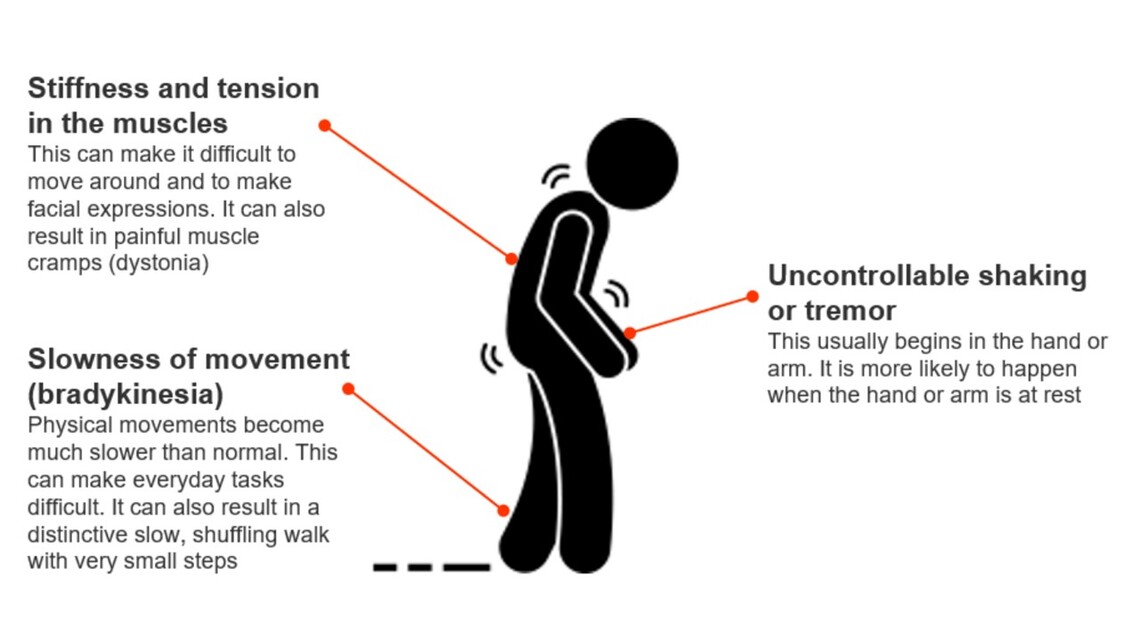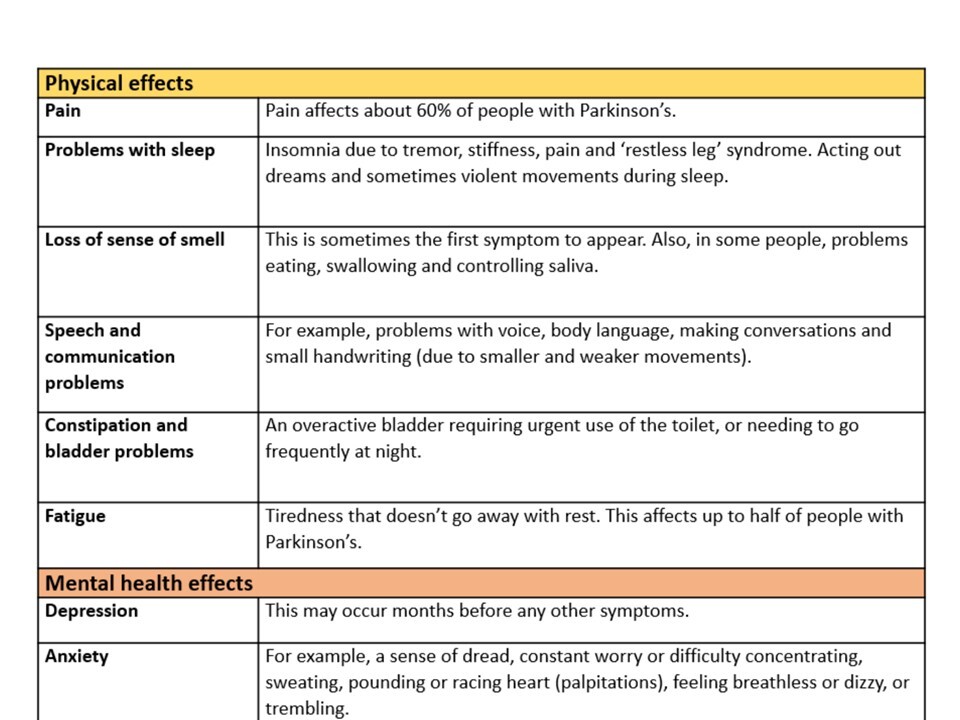- What are the most common symptoms?
- What other symptoms are there?
- Do symptoms vary depending with the individual?
- What causes Parkinson’s?
- Is there anything we can do to lower the risks?
- What to do if you start to experience symptoms
What is Parkinson’s disease?
Parkinson’s disease occurs when nerve cells in the brain stop working properly and are lost over time. These cells produce a chemical called dopamine. Dopamine allows messages to be sent to the parts of the brain that coordinate movement. As dopamine levels fall, movements becoming slower and less controlled.
What are the most common symptoms?
About 145,000 people live with Parkinson’s in the UK. Their symptoms are usually mild at first and develop gradually. The most common symptoms affect bodily movement, such as:
Other movement problems include loss of balance (often leading to falls), and freezing (the inability to move for a moment particularly while making turns or changing direction).
These main symptoms are sometimes referred to by doctors as 'Parkinsonism’. Parkinson’s disease is the most common cause of Parkinsonism. However, there are other conditions which can mimic symptoms of Parkinsonism, so an initial evaluation by an expert neurologist is important to make the correct diagnosis.
What other symptoms are there?
People with Parkinson’s may also experience some (but not all) of the following symptoms:
|
The physical, mental, social and economic burden of Parkinson’s disease is daunting and continues to be the most challenging therapeutic hurdle, especially in the advanced stages of the disease. Journal of Neurology, Neurosurgery and Psychiatry, June 2020 |
Do symptoms vary depending with the individual?
Yes, they do: the order in which symptoms occur, and how serious they are, varies from person to person. Someone with Parkinson’s would usually experience some of the symptoms but not all of them.
Parkinson’s is more common as people get older (over 60 years of age) but sometimes younger people (aged 21 – 40) can get it. This is known as ‘young-onset Parkinson’s’.
Symptoms of people with young-onset Parkinson’s present differently from the late-onset disease. Although young-onset Parkinson’s progresses at a slower rate, the people who show its symptoms are more likely to develop motor complications, including dyskinesia (muscle spasms) when treated with the drug levodopa (a medication that is converted to dopamine in the brain). In addition, the disease has a significant effect not only on these younger families but also on their social and professional lives. More than half of this group (55%) retire early or are likely to give up work within 10 years of the onset of the disease.
What causes Parkinson’s?
Most cases of Parkinson’s disease occur in people with no apparent family history of the disorder. These cases probably result from a complex interaction between environmental and genetic factors.
However, a small number of cases (possibly 15%) appear to be hereditary. Changes have been identified in a number of different genes that can directly cause the disease. People diagnosed with Parkinson’s at a younger age are more likely to have a genetic link.
Environmental risk factors implicated in Parkinson’s disease include pesticide and heavy metal exposure, well water, farming, organic chemicals, dairy products and traumatic head injury, among many others. However, although these links are supported by plausible mechanisms, the studies examining these associations have shown a lack of consistency.
Is there anything we can do to lower the risks?
A 2021 review of 46 systematic reviews reported that the following factors lowered the risk of Parkinson’s disease.
- Dietary factors
- Physical activity
- Cigarette smoking
- Certain medications.
However, there were conflicting results between reviews because of differences in study designs.
Dietary factors were more often associated with a risk of Parkinson’s disease in men than women. This may be due to hormonal and genetic factors. Whether any of these dietary factors directly prevent the onset of Parkinson’s disease requires further investigation.
These diet-related factors may lower the risk of developing Parkinson’s:
- A Mediterranean-type diet of fruit, vegetables, grains, fish, and olive oil.
- Polyunsaturated fatty acids (which help lower your LDL [bad] cholesterol). However, their apparent protective effect may be less when factors such as smoking and caffeine intake are taken into account.
- Higher serum urate levels (uric acid) in the blood
- Caffeine in black tea and coffee.
A growing body of evidence suggests that increased physical activity may reduce the risk of Parkinson’s disease and may partly improve motor and non-motor symptoms during the course of the disease.
|
It is generally acknowledged that a healthy lifestyle consisting of a diet rich in fruit and vegetables together with regular exercise can prevent other chronic diseases and prolong life expectancy. |
Patients with Parkinson’s disease are less likely to smoke, although those who do smoke are at a 40–50% lower risk. Nicotine has been proposed as a substance that lowers PD risk, while the risk of the disease increases with time after quitting smoking. This has led to the proposal by some researchers that smoking may protect against Parkinson’s disease in both men and women. Clinical trials of nicotine treatment have, however, produced mixed results.
Alternatively, this unexpected association between smoking and Parkinson’s disease could be explained by an unknown factor that increases risk and also causes an aversion to smoking. Another explanation – proposed by authors of a study which reported that patients with Parkinson’s disease quit smoking more easily than patients in the control group – is that quitting smoking could be just a ‘pre-clinical marker’ rather than a risk factor. In other words, giving up smoking may be an early sign of the disease.
Certain medications, including ibuprofen, calcium channel blockers, statins, and thiazolidinedione (used in the treatment of diabetes) may also lower the risk of Parkinson’s disease.
What to do if you start to experience symptoms
Seek medical help
If you think that you have symptoms that could be Parkinson’s disease, seek medical help as soon as possible to enable diagnosis and early treatment. There is no cure for Parkinson’s yet, but drugs can help manage the symptoms and slow the progress of the disease.
A healthy diet and exercise can complement medical treatment, including lessening side effects.
Exercise and movement
Exercise and movement are also recommended to reduce the risk of falling (one of the symptoms of Parkinson’s). For example, the English National Ballet and their partners provide Dance for Parkinson’s programmes.
For some people, one side effect of certain Parkinson’s drugs is impulsive and compulsive behaviour, such as compulsive gambling or shopping.
If ‘reduction of dopamine’ therapy is ineffective, the National Institute for Health and Care Excellence (NICE) suggests the use of Cognitive Behavioural Therapy (CBT) – a type of talking therapy – for such compulsive behaviours.
Updated and reviewed by Barbara Baker, September 2021. Next review date August 2025.
_________________________________________
Other relevant articles on the Age Watch website:
- Ageing: Preventing falls as you get older
- Ageing: Caring for Elderly Parents or Partner – Web based Resources
- Mind:
- Mind: A body–mind approach
- Mind: Cognitive Behavioural Therapy
- Mind: The power of positive thinking
- Fitness: Can we dance our way to health?


